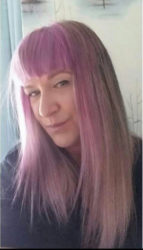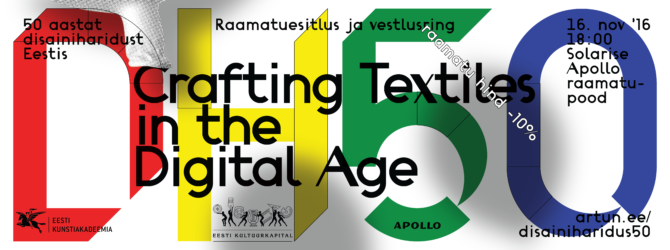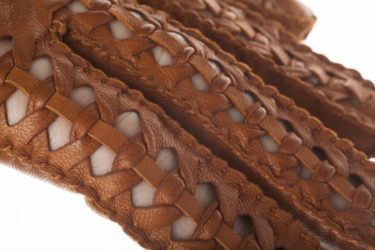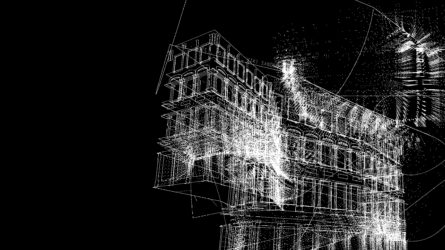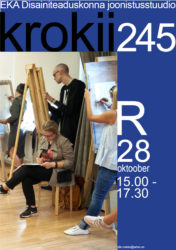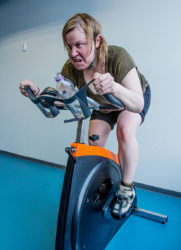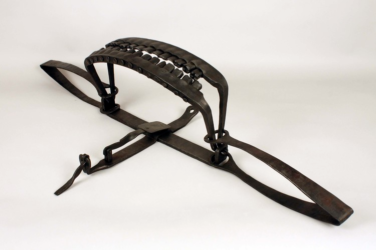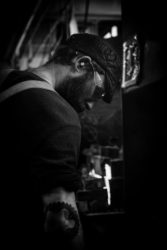Open Lectures
14.11.2016
Open Lecture: Basia Szkutnicka, Love & the Secret of Good Design
What’s ‘good’ design?
It’s so hard to be original.
We’re saturated, don’t we need less, so why design more?
How can we evolve truly unique ideas?
Should ‘good design’ be commercial or could it provide escapism and tempt us to ‘fly’ ?
We’ll examine, contradict, deconstruct, agree and disagree.
You’ll understand how a true designer thinks and be provided with tools to unravel idea generation and creativity as a process, which may then be applied to any design field.
Suitable for: Designers / Students, wanting to become a designer
About Basia Szkutnicka
Susie Menkes described her graduation collection as ‘a breath of fresh air’ in 1988.
Basia has in the last 25 years worked as a freelance design / creative consultant, forecaster, writer, commentator, course director, fashion design educator and run her own label, which provides her with a wealth of knowledge to pass on to this generation of designers to innovate and generate original work.
‘I teach reality, fashion ‘the way it is.
My aim is to excite, be realistic as well as fantastical, to re-energise and above all – wake people up.
Her books, ‘Technical Drawing for Fashion’ (an essential skill for any designer) and ‘Vintage Details: A fashion source book’, are available worldwide.
She is currently based in the UK and works as a freelance consultant. From January 2017, she will be based in Hong Kong as Professor of Practice (Fashion) at Hong Kong Polytechnic University.
Open Lecture: Basia Szkutnicka, Love & the Secret of Good Design
Monday 14 November, 2016
What’s ‘good’ design?
It’s so hard to be original.
We’re saturated, don’t we need less, so why design more?
How can we evolve truly unique ideas?
Should ‘good design’ be commercial or could it provide escapism and tempt us to ‘fly’ ?
We’ll examine, contradict, deconstruct, agree and disagree.
You’ll understand how a true designer thinks and be provided with tools to unravel idea generation and creativity as a process, which may then be applied to any design field.
Suitable for: Designers / Students, wanting to become a designer
About Basia Szkutnicka
Susie Menkes described her graduation collection as ‘a breath of fresh air’ in 1988.
Basia has in the last 25 years worked as a freelance design / creative consultant, forecaster, writer, commentator, course director, fashion design educator and run her own label, which provides her with a wealth of knowledge to pass on to this generation of designers to innovate and generate original work.
‘I teach reality, fashion ‘the way it is.
My aim is to excite, be realistic as well as fantastical, to re-energise and above all – wake people up.
Her books, ‘Technical Drawing for Fashion’ (an essential skill for any designer) and ‘Vintage Details: A fashion source book’, are available worldwide.
She is currently based in the UK and works as a freelance consultant. From January 2017, she will be based in Hong Kong as Professor of Practice (Fashion) at Hong Kong Polytechnic University.
17.11.2016
Open Lecture: Leon van Schaik 17.11 at 6 PM
Leon van Schaik (RMIT) talking in Tallinn about differentiation within an innovative community of practice
On November 17th at 6 pm, the Open Lecture Series of the architecture department is happy to welcome on stage of Kanuti Gildi SAAL prof Leon van Schaik from the RMIT University School of Architecture and Design. The Open Lecture series welcomes all architecture students from across Estonia, professionals of the field and general audience interested in architecture.
Professor Leon van Schaik, Innovation Professor of Architecture at the Royal Melbourne Institute of Technology, promotes local and international architectural culture. His research focuses on creating and sustaining innovative communities of practice. His practice-based research program for architects and designers has become a ground breaking innovation in architectural education worldwide and an important template for research institutions. This approach considers innovative architectural practice as research in of itself, and has far-reaching consequences for how we view architectural practice in an academic context. Van Schaik was awarded the inaugural Neville Quarry Prize for Architectural Education and has been recognised an Officer (AO) in the General Division of the Order of Australia for his services to both architecture and education. Writings include monographs compiled on Edmond and Corrigan, Ushida Findlay, Guilford Bell, Tom Kovac, Poetics in Architecture, The Guthrie Pavilion, The Practice of Practice, and Sean Godsell. Publications include Mastering Architecture (2005), Design City Melbourne (2006) and Spatial Intelligence (2008), Procuring Innovative Architecture with Geoffrey London and Beth George (2010), By Practice By Design: Design Practice Research at RMIT (2011) and Meaning in Space: Housing the visual arts, or Architectures for Private Collections (2012). His most recent book, Practical Poetics in Architecture, was published by Wiley in April 2015.
Open Lecture Series is supported by Estonian Cultural Endowment and organised by the Estonian Academy of Arts architecture department.
Series curated by Sille Pihlak and Siim Tuksam (PART)
www.avatudloengud.ee
FB-page: https://www.facebook.com/events/1003032906475473/
More info:
Pille Epner
arhitektuur@artun.ee
Open Lecture: Leon van Schaik 17.11 at 6 PM
Thursday 17 November, 2016
Leon van Schaik (RMIT) talking in Tallinn about differentiation within an innovative community of practice
On November 17th at 6 pm, the Open Lecture Series of the architecture department is happy to welcome on stage of Kanuti Gildi SAAL prof Leon van Schaik from the RMIT University School of Architecture and Design. The Open Lecture series welcomes all architecture students from across Estonia, professionals of the field and general audience interested in architecture.
Professor Leon van Schaik, Innovation Professor of Architecture at the Royal Melbourne Institute of Technology, promotes local and international architectural culture. His research focuses on creating and sustaining innovative communities of practice. His practice-based research program for architects and designers has become a ground breaking innovation in architectural education worldwide and an important template for research institutions. This approach considers innovative architectural practice as research in of itself, and has far-reaching consequences for how we view architectural practice in an academic context. Van Schaik was awarded the inaugural Neville Quarry Prize for Architectural Education and has been recognised an Officer (AO) in the General Division of the Order of Australia for his services to both architecture and education. Writings include monographs compiled on Edmond and Corrigan, Ushida Findlay, Guilford Bell, Tom Kovac, Poetics in Architecture, The Guthrie Pavilion, The Practice of Practice, and Sean Godsell. Publications include Mastering Architecture (2005), Design City Melbourne (2006) and Spatial Intelligence (2008), Procuring Innovative Architecture with Geoffrey London and Beth George (2010), By Practice By Design: Design Practice Research at RMIT (2011) and Meaning in Space: Housing the visual arts, or Architectures for Private Collections (2012). His most recent book, Practical Poetics in Architecture, was published by Wiley in April 2015.
Open Lecture Series is supported by Estonian Cultural Endowment and organised by the Estonian Academy of Arts architecture department.
Series curated by Sille Pihlak and Siim Tuksam (PART)
www.avatudloengud.ee
FB-page: https://www.facebook.com/events/1003032906475473/
More info:
Pille Epner
arhitektuur@artun.ee
15.11.2016 — 17.11.2016
Crafting Textiles in the Digital Age Book Launch and Lecture Series
In connection with “Design Education 50: 9 Faces of Design Lecture Series” Wednesday 16th Nov, 2016 6.00pm
Venue: Apollo Bookstore, Solaris Centre, Estonia puiestee 9, 11314 Tallinn
The Estonian Academy of Arts cordially invites you to attend the launch event of Crafting Textiles in the Digital Age, recently published by Bloomsbury. The book presents an overview of the concept and role of craft in textile creation and digital technology and the current context and approach taken to the crafting of contemporary digital textiles.
Editors: Nithikul Nimkulrat (Estonian Academy of Arts, EE), Faith Kane (Massey University, NZ) and Kerry Walton (Loughborough University, UK).
Programme
6.00pm – 6.45pm
Welcome and presentations about textile design in the digital era by contributors to the book
Speakers
• Kerry Walton (Loughborough University, UK)
Title: New Creative Opportunities: Textiles, Education & Context
• Anne Louise Bang (Design School Kolding, DK),
Title: Hand Weaving, Digital Tools and Textile Design Education in Denmark
• Susan Carden (Heriot-Watt University, UK)
Title: A Novel Process within Digitally Printed Textile Design
• Katherine Townsend (Nottingham Trent University, UK)
Title:Closely Held Secrets: Embodied Knowledge in Fashion and Textile Practice
6.45pm – 7.00pm
An informal conversation chaired by Dr Nithikul Nimkulrat (Professor and Head of Department of Textile Design, Estonian Academy of Arts) exploring the themes addressed in the book and the future of textile design education
7.00pm – 7.10pm Q&A
7.10pm – 7.30pm Reception
About the Book
In an era of increasingly available digital resources, many textile designers and makers find themselves at an interesting juncture between traditional craft processes and newer digital technologies. Highly specialized craft/design practitioners may now elect to make use of digital processes in their work, but often choose not to abandon craft skills fundamental to their practice, and aim to balance the complex connection between craft and digital processes. The essays collected here consider this transition from the viewpoint of aesthetic opportunity arising in the textile designer’s hands-on experimentation with material and digital technologies available in the present.
For further information, see here
Crafting Textiles in the Digital Age Series of Public Lectures
During the week of the book launch, a series of the following public lectures will take place at the Estonian Academy of Arts’ main building (Estonia puiestee 7, 10143 Tallinn), 4th floor, room 440A
Tuesday 15.11, 3.40pm – 4.30pm Anne Louise Bang
Hand Weaving, Digital Tools and Textile Design Education in Denmark
How are the knowledge and practical experience of traditional processes, specifically hand skills, applied in the context of digital jacquard handloom weaving? This lecture discusses ways in which the introduction of a digital jacquard handloom at the Design School Kolding have influenced the textile design education and thereby the craft and practice of hand weaving in Denmark.
Weavers are generally trained in systematic thinking, as they need to operate traditional looms that require a highly organized way of working, threading warp ends on a number of shafts and inserting weft picks in an accurate order. Regarding the organization of weft yarns, countermarch looms have a number of treadles connected to the shafts, whereas manual or computerized dobby looms work with lift plans. This means that the weaver must understand the interaction between shafts and treadles or lift plans in order to achieve the desired woven pattern. All this changed when we got access to the digital jacquard handloom. With this it became possible to use the loom as a dynamic design tool in textile design education. The lecture will exemplify ways in which digital tools in combination with hand skills and expertise represent a great potential for professional development.
Tuesday 15.11, 4.40pm – 5.30pm Susan Carden
A Novel Process within Digitally Printed Textile Design
In her lecture ‘A Novel Process within Digitally Printed Textile Design’ Dr Susan Carden will be describing a new technique discovered during her practice-led doctoral study at the Glasgow School of Art. While working in the studio she noticed a range of textile samples that she had previously been crafting were extremely cool after a number of days. Following a series of experiments conducted at the Electrical Engineering Department of Glasgow University, this effect was found to be an endothermic reaction, a process that absorbs heat from the surrounding area. This new technique was created during the printing process and numerous potential applications were identified including uses in health, fashion and sports products.
Susan’s presentation will describe the stages this discovery took and the implications for both her study and practice-led projects in general when alternative research methods are required. The scientific nature of the discovery was also a challenge in an art school setting, and this will be explored with references to the methodologies and research techniques she needed to adopt in order to successfully complete her doctoral project.
Wednesday 16.11, 4.40pm – 5.30pm Katherine Townsend
Closely Held Secrets: Embodied Knowledge in Fashion and Textile Practice
This lecture provides an overview of Closely Held Secrets, a research project and exhibition inspired by the hidden working relationship between the artist Grayson Perry and artisan Tony Taylor, which was adopted as a model by a group of individual artists/designers to explore digital embroidery as a new media. It will also discuss emerging methodologies and outcomes from current collaborative research projects that Katherine is involved in:Crafting Anatomies, The Electric Corset and Emotional Fit, which draw upon concealed material resources and embodied human interactions to inform design innovation.
Thursday 17.11, 4.40pm – 5.30pm – Kerry Walton
Technology, Tradition, Transition: Defining and Negotiating New Pathways in Contemporary Textile Design Education.
Change defines the modern world and Textile practitioners have always adapted to and ultimately thrived in response to the adaptation of new technologies. The fast pace of change in the last 2 decades, largely driven by the wide availability of digital media, and production capability within a broader global context, has necessitated a swift response by educational institutions, and significant reflection on where the priorities might lie for our students. With experience of design education spanning 5 decades I will be mapping a journey through this changing terrain, both as educator, researcher and practitioner, reflecting on the integration of traditional craft skills, digital opportunities and the ability of drawing to facilitate this relationship.
Speakers’ Biographies
Dr Nithikul Nimkulrat
Dr Nithikul Nimkulrat intertwines research with textile practice, focusing on experiential knowledge in craft processes in the design research context. Her PhD research completed in 2009 at Aalto University examines the expressivity of textile material that is beyond visible, touchable qualities. Nithikul has worked at Aalto University (2004–10) and Loughborough University (2011–2013), and is currently Professor and Head of Department of Textile Design at the Estonian Academy of Arts.
Kerry Walton
Kerry Walton
Kerry Walton is the Programme Director for Textiles: Innovation & Design, at Loughborough University, rated 1st in the UK for Fashion and Textiles (The Guardian University Guide 2017). Her current research explores the relationship between drawing and textiles, both within her own practice and within the scope of a contemporary Textiles education.
Dr. Anne Louise Bang
Dr. Anne Louise Bang
Dr Anne Louise Bang is an Associate Professor at Design School Kolding in Denmark. She earned her PhD in 2011 with the thesis Emotional Value of Applied Textiles. Bang was educated as a textile designer in 1994, and before entering academia around 2007 she worked with textile art, freelance design and as a lecturer.
Dr Susan Carden
Dr Susan Carden
Dr Susan Carden is an Assistant Professor in Textile Design at Heriot-Watt University and a Visiting Lecturer at the Glasgow School of Art’s Graduate School.Her monograph Digital Textile Printing: Art, Design, Culture describes the historical and cultural context from which digital textile printing emerged and engages critically with the many issues it raises.
Dr Katherine Townsend
Dr Katherine Townsend
Dr Katherine Townsend is a Reader in Fashion and Textile Crafts at Nottingham Trent University. Her current research projects, Emotional Fit and The Electric Corset explore design issues in fashion and aging and the use of costume archives to inform interactive wearable technology. She is a supervisor and external examiner for PhD theses on digital crafting approaches, including 3D knitting and weaving, laser cutting and sustainable fashion and textile design. She has co-curated various exhibitions, including: Metallic Sound, Closely Held Secrets and Crafting Anatomies. Since 2010 she has acted as co-editor of the journal of Craft Research (Intellect).
* The book launch and series of public lectures are supported by the Cultural Endowment of Estonia.
Crafting Textiles in the Digital Age Book Launch and Lecture Series
Tuesday 15 November, 2016 — Thursday 17 November, 2016
In connection with “Design Education 50: 9 Faces of Design Lecture Series” Wednesday 16th Nov, 2016 6.00pm
Venue: Apollo Bookstore, Solaris Centre, Estonia puiestee 9, 11314 Tallinn
The Estonian Academy of Arts cordially invites you to attend the launch event of Crafting Textiles in the Digital Age, recently published by Bloomsbury. The book presents an overview of the concept and role of craft in textile creation and digital technology and the current context and approach taken to the crafting of contemporary digital textiles.
Editors: Nithikul Nimkulrat (Estonian Academy of Arts, EE), Faith Kane (Massey University, NZ) and Kerry Walton (Loughborough University, UK).
Programme
6.00pm – 6.45pm
Welcome and presentations about textile design in the digital era by contributors to the book
Speakers
• Kerry Walton (Loughborough University, UK)
Title: New Creative Opportunities: Textiles, Education & Context
• Anne Louise Bang (Design School Kolding, DK),
Title: Hand Weaving, Digital Tools and Textile Design Education in Denmark
• Susan Carden (Heriot-Watt University, UK)
Title: A Novel Process within Digitally Printed Textile Design
• Katherine Townsend (Nottingham Trent University, UK)
Title:Closely Held Secrets: Embodied Knowledge in Fashion and Textile Practice
6.45pm – 7.00pm
An informal conversation chaired by Dr Nithikul Nimkulrat (Professor and Head of Department of Textile Design, Estonian Academy of Arts) exploring the themes addressed in the book and the future of textile design education
7.00pm – 7.10pm Q&A
7.10pm – 7.30pm Reception
About the Book
In an era of increasingly available digital resources, many textile designers and makers find themselves at an interesting juncture between traditional craft processes and newer digital technologies. Highly specialized craft/design practitioners may now elect to make use of digital processes in their work, but often choose not to abandon craft skills fundamental to their practice, and aim to balance the complex connection between craft and digital processes. The essays collected here consider this transition from the viewpoint of aesthetic opportunity arising in the textile designer’s hands-on experimentation with material and digital technologies available in the present.
For further information, see here
Crafting Textiles in the Digital Age Series of Public Lectures
During the week of the book launch, a series of the following public lectures will take place at the Estonian Academy of Arts’ main building (Estonia puiestee 7, 10143 Tallinn), 4th floor, room 440A
Tuesday 15.11, 3.40pm – 4.30pm Anne Louise Bang
Hand Weaving, Digital Tools and Textile Design Education in Denmark
How are the knowledge and practical experience of traditional processes, specifically hand skills, applied in the context of digital jacquard handloom weaving? This lecture discusses ways in which the introduction of a digital jacquard handloom at the Design School Kolding have influenced the textile design education and thereby the craft and practice of hand weaving in Denmark.
Weavers are generally trained in systematic thinking, as they need to operate traditional looms that require a highly organized way of working, threading warp ends on a number of shafts and inserting weft picks in an accurate order. Regarding the organization of weft yarns, countermarch looms have a number of treadles connected to the shafts, whereas manual or computerized dobby looms work with lift plans. This means that the weaver must understand the interaction between shafts and treadles or lift plans in order to achieve the desired woven pattern. All this changed when we got access to the digital jacquard handloom. With this it became possible to use the loom as a dynamic design tool in textile design education. The lecture will exemplify ways in which digital tools in combination with hand skills and expertise represent a great potential for professional development.
Tuesday 15.11, 4.40pm – 5.30pm Susan Carden
A Novel Process within Digitally Printed Textile Design
In her lecture ‘A Novel Process within Digitally Printed Textile Design’ Dr Susan Carden will be describing a new technique discovered during her practice-led doctoral study at the Glasgow School of Art. While working in the studio she noticed a range of textile samples that she had previously been crafting were extremely cool after a number of days. Following a series of experiments conducted at the Electrical Engineering Department of Glasgow University, this effect was found to be an endothermic reaction, a process that absorbs heat from the surrounding area. This new technique was created during the printing process and numerous potential applications were identified including uses in health, fashion and sports products.
Susan’s presentation will describe the stages this discovery took and the implications for both her study and practice-led projects in general when alternative research methods are required. The scientific nature of the discovery was also a challenge in an art school setting, and this will be explored with references to the methodologies and research techniques she needed to adopt in order to successfully complete her doctoral project.
Wednesday 16.11, 4.40pm – 5.30pm Katherine Townsend
Closely Held Secrets: Embodied Knowledge in Fashion and Textile Practice
This lecture provides an overview of Closely Held Secrets, a research project and exhibition inspired by the hidden working relationship between the artist Grayson Perry and artisan Tony Taylor, which was adopted as a model by a group of individual artists/designers to explore digital embroidery as a new media. It will also discuss emerging methodologies and outcomes from current collaborative research projects that Katherine is involved in:Crafting Anatomies, The Electric Corset and Emotional Fit, which draw upon concealed material resources and embodied human interactions to inform design innovation.
Thursday 17.11, 4.40pm – 5.30pm – Kerry Walton
Technology, Tradition, Transition: Defining and Negotiating New Pathways in Contemporary Textile Design Education.
Change defines the modern world and Textile practitioners have always adapted to and ultimately thrived in response to the adaptation of new technologies. The fast pace of change in the last 2 decades, largely driven by the wide availability of digital media, and production capability within a broader global context, has necessitated a swift response by educational institutions, and significant reflection on where the priorities might lie for our students. With experience of design education spanning 5 decades I will be mapping a journey through this changing terrain, both as educator, researcher and practitioner, reflecting on the integration of traditional craft skills, digital opportunities and the ability of drawing to facilitate this relationship.
Speakers’ Biographies
Dr Nithikul Nimkulrat
Dr Nithikul Nimkulrat intertwines research with textile practice, focusing on experiential knowledge in craft processes in the design research context. Her PhD research completed in 2009 at Aalto University examines the expressivity of textile material that is beyond visible, touchable qualities. Nithikul has worked at Aalto University (2004–10) and Loughborough University (2011–2013), and is currently Professor and Head of Department of Textile Design at the Estonian Academy of Arts.
Kerry Walton
Kerry Walton
Kerry Walton is the Programme Director for Textiles: Innovation & Design, at Loughborough University, rated 1st in the UK for Fashion and Textiles (The Guardian University Guide 2017). Her current research explores the relationship between drawing and textiles, both within her own practice and within the scope of a contemporary Textiles education.
Dr. Anne Louise Bang
Dr. Anne Louise Bang
Dr Anne Louise Bang is an Associate Professor at Design School Kolding in Denmark. She earned her PhD in 2011 with the thesis Emotional Value of Applied Textiles. Bang was educated as a textile designer in 1994, and before entering academia around 2007 she worked with textile art, freelance design and as a lecturer.
Dr Susan Carden
Dr Susan Carden
Dr Susan Carden is an Assistant Professor in Textile Design at Heriot-Watt University and a Visiting Lecturer at the Glasgow School of Art’s Graduate School.Her monograph Digital Textile Printing: Art, Design, Culture describes the historical and cultural context from which digital textile printing emerged and engages critically with the many issues it raises.
Dr Katherine Townsend
Dr Katherine Townsend
Dr Katherine Townsend is a Reader in Fashion and Textile Crafts at Nottingham Trent University. Her current research projects, Emotional Fit and The Electric Corset explore design issues in fashion and aging and the use of costume archives to inform interactive wearable technology. She is a supervisor and external examiner for PhD theses on digital crafting approaches, including 3D knitting and weaving, laser cutting and sustainable fashion and textile design. She has co-curated various exhibitions, including: Metallic Sound, Closely Held Secrets and Crafting Anatomies. Since 2010 she has acted as co-editor of the journal of Craft Research (Intellect).
* The book launch and series of public lectures are supported by the Cultural Endowment of Estonia.
29.11.2016
Riina Õun artist talk
http://www.riinao.com/
https://www.notjustalabel.com/designer/6un#page-1
Riina Õun artist talk
Tuesday 29 November, 2016
http://www.riinao.com/
https://www.notjustalabel.com/designer/6un#page-1
03.11.2016
Open Lecture: Bernhard Sommer & GALO moncayo 3.11 at 6 PM
Bernhard Sommer and Galo Moncayo Open Lecture to focus on energy efficient future cities
On November 3rd at 6 pm, the Open Lecture Series of the architecture faculty will be happy to present architect Bernhard Sommer from Exikon and architect and installation artist Galo Moncayo at Estonian Architecture Centre (Kultuurikatel, Põhja pst 27a, Tallinn). Sommer teaches energy design at one of the most exciting architecture schools in the world, Universität für angewandte Kunst Wien, and leads Exikon arc & dev architecture office, dedicated to the application of cutting-edge planning and building technology. Moncayo is an established installation artist and architect who teaches at the Universität für angewandte Kunst Wien. Open Lecture Series welcome all architecture students from across Estonia, professionals and general audience intrigued by spatial matters: the lectures are in English and free of charge.
From this academic year, and with generous help from Merko construction company, Sommer will also be teaching at the Estonian Academy of Art architecture department. In his Open Lecture, Sommer will explain how energy design can fundamentally change the way future cities are designed. In Estonia, the prevailing method of raising energy efficiency of a building has been dealt with by adding energy efficient components and materials to a project, whereas Sommer guides his students to employ smart spatial geometry to make cities and buildings more efficient. Sommer’s architecture office, Exikon arc & dev in Vienna, is dedicated to the application of cutting-edge planning and building technology. Its aim is the integration of scientific findings into the design process.
Bernhard Sommer teaches energy design at the University of Applied Arts Vienna, and has been a visiting professor at the Institute for Experimental Architecture at the University of Innsbruck. Sommer also teaches building physics and holds seminars on sustainable design at the Technical University of Graz, the University of Cagliari and in the context of the Master Program Urban Strategies. In 2000, he has been awarded the Arch + Prize 2000, in 2002, the Schindler Scholarship of the MAK Center in Los Angeles. There he developed the transforming „desert cloud“ project that later was exhibited in West Hollywood and Vienna.
Galo Moncayo is an installation artist and architect currently teaching in the Energy Design Department at the University of Applied Arts in Vienna, as well as a Assistant Professor in the Experimental Architecture Department at Innsbruck University. He has exhibited throughout the United States including in New York, and in Germany, Mexico, Austria, Spain and has been invited as a visiting artist/ lecturer at Carnegie Mellon University, The George Washington University, among other universities in North America and in Germany, Mexico, Austria and Ecuador. Galo Moncayo received a Magister of Architecture from the University of Applied Arts in Vienna in the Zaha Hadid Master Class, a Master of Fine Arts in sculpture from Virginia Commonwealth University and a Bachelor of Fine Arts in sculpture from the Maryland Institute, College of Art in the United States.
More about Exikon: http://www.exikon.at/
Open Lecture Series is supported by Estonian Cultural Endowment and organised by the Estonian Academy of Arts architecture department. The architecture department would also like to thank Merko for their support for this event.
Series curated by Sille Pihlak and Siim Tuksam (PART)
www.avatudloengud.ee
More info:
Pille Epner
arhitektuur@artun.ee
+372 642 0071
Open Lecture: Bernhard Sommer & GALO moncayo 3.11 at 6 PM
Thursday 03 November, 2016
Bernhard Sommer and Galo Moncayo Open Lecture to focus on energy efficient future cities
On November 3rd at 6 pm, the Open Lecture Series of the architecture faculty will be happy to present architect Bernhard Sommer from Exikon and architect and installation artist Galo Moncayo at Estonian Architecture Centre (Kultuurikatel, Põhja pst 27a, Tallinn). Sommer teaches energy design at one of the most exciting architecture schools in the world, Universität für angewandte Kunst Wien, and leads Exikon arc & dev architecture office, dedicated to the application of cutting-edge planning and building technology. Moncayo is an established installation artist and architect who teaches at the Universität für angewandte Kunst Wien. Open Lecture Series welcome all architecture students from across Estonia, professionals and general audience intrigued by spatial matters: the lectures are in English and free of charge.
From this academic year, and with generous help from Merko construction company, Sommer will also be teaching at the Estonian Academy of Art architecture department. In his Open Lecture, Sommer will explain how energy design can fundamentally change the way future cities are designed. In Estonia, the prevailing method of raising energy efficiency of a building has been dealt with by adding energy efficient components and materials to a project, whereas Sommer guides his students to employ smart spatial geometry to make cities and buildings more efficient. Sommer’s architecture office, Exikon arc & dev in Vienna, is dedicated to the application of cutting-edge planning and building technology. Its aim is the integration of scientific findings into the design process.
Bernhard Sommer teaches energy design at the University of Applied Arts Vienna, and has been a visiting professor at the Institute for Experimental Architecture at the University of Innsbruck. Sommer also teaches building physics and holds seminars on sustainable design at the Technical University of Graz, the University of Cagliari and in the context of the Master Program Urban Strategies. In 2000, he has been awarded the Arch + Prize 2000, in 2002, the Schindler Scholarship of the MAK Center in Los Angeles. There he developed the transforming „desert cloud“ project that later was exhibited in West Hollywood and Vienna.
Galo Moncayo is an installation artist and architect currently teaching in the Energy Design Department at the University of Applied Arts in Vienna, as well as a Assistant Professor in the Experimental Architecture Department at Innsbruck University. He has exhibited throughout the United States including in New York, and in Germany, Mexico, Austria, Spain and has been invited as a visiting artist/ lecturer at Carnegie Mellon University, The George Washington University, among other universities in North America and in Germany, Mexico, Austria and Ecuador. Galo Moncayo received a Magister of Architecture from the University of Applied Arts in Vienna in the Zaha Hadid Master Class, a Master of Fine Arts in sculpture from Virginia Commonwealth University and a Bachelor of Fine Arts in sculpture from the Maryland Institute, College of Art in the United States.
More about Exikon: http://www.exikon.at/
Open Lecture Series is supported by Estonian Cultural Endowment and organised by the Estonian Academy of Arts architecture department. The architecture department would also like to thank Merko for their support for this event.
Series curated by Sille Pihlak and Siim Tuksam (PART)
www.avatudloengud.ee
More info:
Pille Epner
arhitektuur@artun.ee
+372 642 0071
28.10.2016
Croquis.
This time the model in EAA Design Faculty’s drawing studio’s croquis is Julia.
Croquis.
Friday 28 October, 2016
This time the model in EAA Design Faculty’s drawing studio’s croquis is Julia.
19.10.2016
Open Lecture MARTTA TUOMAALA: Artistic methods for making a difference, 19 October at 5 pm, graphic art department, Lembitu 10B, ruum 144
MARTTA TUOMAALA: Artistic methods for making a difference
On Wednesday, 19 October at 5 pm there will be an open lecture Artistic methods for making a difference by Finnish artist and filmmaker Martta Tuomaala. She is the guest lecturer at the graphic art and installation/sculpture departments at the autumn semester. The lecture will take place at EKA Lembitu 10B building in room no 144
Martta Tuomaala (b. 1983) is a visual artist, currently living and working in Helsinki. She gained a Master’s degree in Fine Art from Aalto University, School of Arts and Architecture in 2014.
Tuomaala is a multidisciplinary artist who focuses mainly on various forms of film, video and socially engaged art. Her works deals with social, societal structures and power relations. Tuomaala has been working in several low-paid sectors, which has made a strong impact in her artistic practice. The main focus of her interest is work: research of working culture, working conditions, labor struggles, workers’ rights and different forms of organizing, especially in the low-paid and precarious women-dominated fields. One of her biggest projects Cleaner’s Voice, which combines different methods of artistic practice and militant research, consists of a 16-channel installation which is based on the interviews of cleaners.
Currently she is working on a project Finn-Spinning-Soumi-Perkele! dealing with generalized ideas of ‘Finnishness’, precarious work and the effects of austerity politics in Finland.
More information:
www.marttatuomaala.com
www.facebook.com/cleanersvoice
Olete oodatud!
You are warmly welcome!
Open Lecture MARTTA TUOMAALA: Artistic methods for making a difference, 19 October at 5 pm, graphic art department, Lembitu 10B, ruum 144
Wednesday 19 October, 2016
MARTTA TUOMAALA: Artistic methods for making a difference
On Wednesday, 19 October at 5 pm there will be an open lecture Artistic methods for making a difference by Finnish artist and filmmaker Martta Tuomaala. She is the guest lecturer at the graphic art and installation/sculpture departments at the autumn semester. The lecture will take place at EKA Lembitu 10B building in room no 144
Martta Tuomaala (b. 1983) is a visual artist, currently living and working in Helsinki. She gained a Master’s degree in Fine Art from Aalto University, School of Arts and Architecture in 2014.
Tuomaala is a multidisciplinary artist who focuses mainly on various forms of film, video and socially engaged art. Her works deals with social, societal structures and power relations. Tuomaala has been working in several low-paid sectors, which has made a strong impact in her artistic practice. The main focus of her interest is work: research of working culture, working conditions, labor struggles, workers’ rights and different forms of organizing, especially in the low-paid and precarious women-dominated fields. One of her biggest projects Cleaner’s Voice, which combines different methods of artistic practice and militant research, consists of a 16-channel installation which is based on the interviews of cleaners.
Currently she is working on a project Finn-Spinning-Soumi-Perkele! dealing with generalized ideas of ‘Finnishness’, precarious work and the effects of austerity politics in Finland.
More information:
www.marttatuomaala.com
www.facebook.com/cleanersvoice
Olete oodatud!
You are warmly welcome!
19.10.2016
Open Lecture: Tomaž Zupančič and Jan van Boeckel “Perspectives on art education in today’s global economy” 19th October
We are glad to inform You about an upcoming open lecture in the Department of Art Education expanding upon the topic “Perspectives on art education in today’s global economy”.
Lecturers: Tomaž Zupančič, Professor at the Faculty of Education, University in Maribor, Slovenia
and
Jan van Boeckel, Professor in Art Pedagogy at the Faculty of Art and Culture, Estonian Academy of Arts
In our conversation we bring together the themes of art, art education and economy. Some people would hold that art is only worthwhile if it is completely interest-free (“l’art pour l’art”). But what happens when one engages with art for purposes that are external to its supposed own domain, for example when artmaking becomes an instrument to seek economic gains, to draw a spicy personal career plan or even to push society into a more sustainable direction? Is it still art then? And what are the implications of our views on this issue for the kind of art education we provide to young people?
Time: Wednesday 19 October, 12.30-14.30
Place: Estonian Academy of Arts,
Department of Art Education, Room 103, Suur-Kloostri 11, Tallinn
Info: Helen Arov (helen.arov@artun.ee)
Hope to see You soon!
Department of Art Education
Open Lecture: Tomaž Zupančič and Jan van Boeckel “Perspectives on art education in today’s global economy” 19th October
Wednesday 19 October, 2016
We are glad to inform You about an upcoming open lecture in the Department of Art Education expanding upon the topic “Perspectives on art education in today’s global economy”.
Lecturers: Tomaž Zupančič, Professor at the Faculty of Education, University in Maribor, Slovenia
and
Jan van Boeckel, Professor in Art Pedagogy at the Faculty of Art and Culture, Estonian Academy of Arts
In our conversation we bring together the themes of art, art education and economy. Some people would hold that art is only worthwhile if it is completely interest-free (“l’art pour l’art”). But what happens when one engages with art for purposes that are external to its supposed own domain, for example when artmaking becomes an instrument to seek economic gains, to draw a spicy personal career plan or even to push society into a more sustainable direction? Is it still art then? And what are the implications of our views on this issue for the kind of art education we provide to young people?
Time: Wednesday 19 October, 12.30-14.30
Place: Estonian Academy of Arts,
Department of Art Education, Room 103, Suur-Kloostri 11, Tallinn
Info: Helen Arov (helen.arov@artun.ee)
Hope to see You soon!
Department of Art Education
20.10.2016
Open Lecture Series: Jakob Lange (BIG) 20.10 at 6 PM
The story of the unbuilt town hall:
On October 20th at 6 pm, the Open Lecture Series of the architecture faculty will be happy to present architect Jakob Lange from BIG (Bjarke Ingels Group) at Kanuti Gildi SAAL (Pikk 20, Tallinn). Lange has been working for years on BIG’s proposal for Tallinn’s new town hall – the project that won the competition in 2009 and is yet to be built today, and has promised to share the story of the “village” typology proposed by BIG. Could architecture improve communication between people and the city government? Open Lectures are open to all architecture students, professionals and general audience intrigued by spatial matters: the lectures are in English and free of charge.
Jakob Lange is a partner at BIG and has collaborated with Bjarke Ingels since 2003. As a project leader for several award-winning projects, Jakob has been instrumental to many of BIG’s largest commissions. He led the design and development of The Mountain mixed-use residences in Copenhagen, completed in 2008, and served as the Project Leader for the new Tallinn Town Hall in Estonia, which received a MIPIM Future Award 2011. He is currently Partner in Charge of Stettin 7, a 20.000 m2 sustainable luxury residential building in Stockholm, Sweden. Jakob also heads BIG IDEAS, BIG’s technology driven special projects division. Through analysis and simulation, BIG IDEAS informs BIG’s design decisions with research-based information—Information Driven Design. Special projects, including a green window farm, customized furniture, and innovative building systems support the studio’s work from small details to the BIG picture.
More about BIG’s Tallinn town hall project: http://big.dk/#projects-tat
Open Lecture Series is supported by Estonian Cultural Endowment and organised by the Estonian Academy of Arts architecture department.
Series curated by Sille Pihlak and Siim Tuksam (PART)
www.avatudloengud.ee
More info:
Lisainfo:
Pille Epner
arhitektuur@artun.ee
+372 642 0071
Open Lecture Series: Jakob Lange (BIG) 20.10 at 6 PM
Thursday 20 October, 2016
The story of the unbuilt town hall:
On October 20th at 6 pm, the Open Lecture Series of the architecture faculty will be happy to present architect Jakob Lange from BIG (Bjarke Ingels Group) at Kanuti Gildi SAAL (Pikk 20, Tallinn). Lange has been working for years on BIG’s proposal for Tallinn’s new town hall – the project that won the competition in 2009 and is yet to be built today, and has promised to share the story of the “village” typology proposed by BIG. Could architecture improve communication between people and the city government? Open Lectures are open to all architecture students, professionals and general audience intrigued by spatial matters: the lectures are in English and free of charge.
Jakob Lange is a partner at BIG and has collaborated with Bjarke Ingels since 2003. As a project leader for several award-winning projects, Jakob has been instrumental to many of BIG’s largest commissions. He led the design and development of The Mountain mixed-use residences in Copenhagen, completed in 2008, and served as the Project Leader for the new Tallinn Town Hall in Estonia, which received a MIPIM Future Award 2011. He is currently Partner in Charge of Stettin 7, a 20.000 m2 sustainable luxury residential building in Stockholm, Sweden. Jakob also heads BIG IDEAS, BIG’s technology driven special projects division. Through analysis and simulation, BIG IDEAS informs BIG’s design decisions with research-based information—Information Driven Design. Special projects, including a green window farm, customized furniture, and innovative building systems support the studio’s work from small details to the BIG picture.
More about BIG’s Tallinn town hall project: http://big.dk/#projects-tat
Open Lecture Series is supported by Estonian Cultural Endowment and organised by the Estonian Academy of Arts architecture department.
Series curated by Sille Pihlak and Siim Tuksam (PART)
www.avatudloengud.ee
More info:
Lisainfo:
Pille Epner
arhitektuur@artun.ee
+372 642 0071
05.10.2016
ZACH LIHATSH open lecture on Oct 5 at 6 pm
Artist statement:
I strive to explore the tension between industry and the organic. I choose forged steel as my primary method. I do this because forged steel retains an industrial weight as it simultaneously can be made plastic and non linear. Within this merging duality I find a larger narrative. These feelings resonate with my own interests in understanding how we as a people seek to find balance in the world. A balance of our own.
The industrial ruins that dot the American landscape inspire some forms in my work. Other forms are directly related to anatomy and the human body. A recent body of work explores the aesthetic nature of graffiti that dominates these industrial ruins. It is my goal to explore the flux of human impact on the natural world and to comment on our social and physical impact through this exploration.
Zachary Lihatsh is an artist, designer, and blacksmith. Born and raised in New Hampshire, Zach later settled in Arizona where he established his studio. He received his undergraduate degree form Prescott College in northern Arizona and is currently an MFA candidate at Southern Illinois University in Carbondale, Illinois. He has taught blacksmithing at high school and college levels as well as assisting at the Penland School of craft in North Carolina. He has exhibited work nationally and internationally. His Public art commissions can be seen in Tucson, Arizona and at The University of Gothenburg, Sweden.
www.zachlihatsh.com
ZACH LIHATSH open lecture on Oct 5 at 6 pm
Wednesday 05 October, 2016
Artist statement:
I strive to explore the tension between industry and the organic. I choose forged steel as my primary method. I do this because forged steel retains an industrial weight as it simultaneously can be made plastic and non linear. Within this merging duality I find a larger narrative. These feelings resonate with my own interests in understanding how we as a people seek to find balance in the world. A balance of our own.
The industrial ruins that dot the American landscape inspire some forms in my work. Other forms are directly related to anatomy and the human body. A recent body of work explores the aesthetic nature of graffiti that dominates these industrial ruins. It is my goal to explore the flux of human impact on the natural world and to comment on our social and physical impact through this exploration.
Zachary Lihatsh is an artist, designer, and blacksmith. Born and raised in New Hampshire, Zach later settled in Arizona where he established his studio. He received his undergraduate degree form Prescott College in northern Arizona and is currently an MFA candidate at Southern Illinois University in Carbondale, Illinois. He has taught blacksmithing at high school and college levels as well as assisting at the Penland School of craft in North Carolina. He has exhibited work nationally and internationally. His Public art commissions can be seen in Tucson, Arizona and at The University of Gothenburg, Sweden.
www.zachlihatsh.com

